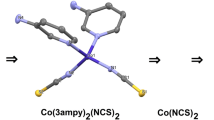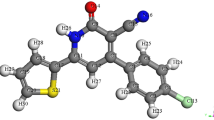Abstract
Novel complexes of type [M2LCl4]·nH2O ((1) M:Ni, n = 5; (2) M:Cu, n = 0 and (3) M:Zn, n = 2; L: ligand resulted from 1,2-phenylenediamine, 3,6-diazaoctane-1,8-diamine and formaldehyde template condensation) were synthesised and characterised. The features of complexes have been assigned from microanalytical, IR and UV–Vis data. The thermal analyses have evidenced the thermal intervals of stability and also the thermodynamic effects that accompany them. Processes as water or hydrochloric acid elimination as well as oxidative degradation of the organic ligand were observed. Complexes display a different thermal behaviour as result of dissimilar chemical interaction of metal ions with chloride anions. The final product of decomposition was metal(II) oxide as powder X-ray diffraction indicated.





Similar content being viewed by others
References
Gielen M, Tiekink RT, editors. Metallotherapeutic drugs and metal-based diagnostic agents. The use of metals in medicine. Chichester, England: Wiley; 2005.
Schols D, Esté JA, Henson G, De Clercq E. Bicyclams, a class of potent anti-HIV agents, are targeted at the HIV coreceptor fusin/CXCR-4. Antiviral Res. 1997;35:147–56.
Gerlach LO, Skerlj RT, Bridger GJ, Schwartz TW. Molecular interactions of cyclam and bicyclam non-peptide antagonists with the CXCR4 chemokine receptor. J Biol Chem. 2001;276:14153–60.
Liang X, Sadler PJ. Cyclam complexes and their applications in medicine. Chem Soc Rev. 2004;33:246–66.
Fricker SP, Anastassov V, Cox J, Darkes MC, Grujic O, Idzan SR, Labrecque J, Lau G, Mosi RM, Nelson KL, Qin L, Santucci Z, Wong RSY. Characterization of the molecular pharmacology of AMD3100: a specific antagonist of the G-protein coupled chemokine receptor, CXCR4. Biochem Pharmacol. 2006;72:588–96.
De Clercq E. Inhibition of HIV infection by bicyclams, highly potent and specific CXCR4 antagonists. Mol Pharmacol. 2000;57:833–9.
Liang X, Parkinson JA, Weishäupl M, Gould RO, Paisey SJ, Park H-S, Hunter TM, Blindauer CA, Parsons S, Sadler PJ. Structure and dynamics of metallomacrocycles: recognition of zinc xylyl-bicyclam by an HIV coreceptor. J Am Chem Soc. 2002;124:9105–12.
Valks GC, McRobbie G, Lewis EA, Hubin TJ, Hunter TM, Sadler PJ, Pannecouque C, De Clercq E, Archibald SJ. Configurationally restricted bismacrocyclic CXCR4 receptor antagonists. J Med Chem. 2006;49:6162–5.
Affani R, Pélissier F, Aubertin A-M, Dugat D. Bis-14-membered ring diketal diamines: synthesis and evaluation of their anti-HIV and anti-tumoral activities. Eur J Med Chem. 2009;44:3138–46.
Arjmand F, Aziz M. Synthesis and biophysical studies of bis-macrocyclic cobalt/copper(II) complexes having a pyridine spacer with CT DNA and 5′-GMP. Chem Biodivers. 2009;6:2275–89.
Kang S-G, Ryu K, Suh MP, Jeong JH. Template synthesis and crystal structure of a novel mononuclear nickel(II) complex with a face-to-face bis(macrocyclic) ligand. Inorg Chem. 1997;36:2478–81.
Kang S-G, Song J, Jeong JH. Synthesis and characterization of new unsaturated macrobicyclic and bis(macrocyclic) copper(II) complexes containing N–CH2–N linkages. Inorg Chim Acta. 2004;357:605–10.
Salavati-Niasari M, Bazarganipour M. Bis(macrocyclic) copper(II) complexes containing aromatic nitrogen–nitrogen linkers produced by in situ one pot template condensation reaction (IOPTCR): synthesis, characterization and catalytic oxidation of tetrahydrofuran. Inorg Chem Commun. 2006;9:332–6.
Chandra S, Jain D, Ratnam B. Synthesis and spectroscopic characterization of copper (II) metal complexes of a 16 membered pentaaza (N5) bis (macrocyclic) complexes. J Chem Pharm Res. 2010;2:533–8.
Olar R, Badea M, Stanica N, Cristurean E, Marinescu D. Synthesis, characterisation and thermal behaviour of some complexes with ligands having 1,3,4-thiadiazole moieties. J Therm Anal Calorim. 2005;82:417–22.
Olar R, Badea M, Marinescu D, Lazar V, Chifiriuc C. Thermal behaviour of new Ni(II) and Cu(II) complexes with macrocyclic ligands functionalised with 1,2,4-triazole. J Therm Anal Calorim. 2009;97:315–21.
Salavati-Niasari M, Amiri A. Binuclear copper(II) complexes of new bis(macrocyclic) 16-membered pentaaza subunits are linked together by bridging nitrogen of amine: synthesis, characterization and catalytic activity. J Mol Catal A. 2005;235:114–21.
Nakamoto K. Infrared and Raman spectra of inorganic and coordination compounds. New York: Wiley; 1986. p. 228–9.
Lever ABP. Inorganic electronic spectroscopy. Amsterdam, London, New York: Elsevier; 1986. p. 534–42, 560–7.
Olar R, Badea M, Marinescu D. Thermal study of some new Ni(II) and Cu(II) complexes with ligands derived from N,N-dimethylbiguanide as potential antimicrobials. J Therm Anal Calorim. 2010;99:893–8.
Mészáros Szécsényi K, Leovac VM, Kovács A, Pokol G, Jaćimović K. Transition metal complexes with pyrazole-based ligands Part 21. Thermal decomposition of copper and cobalt halide complexes with 3,5-dimethyl-1-thiocarboxamidepyrazole. J Therm Anal Calorim. doi:10.1007/s10973-005-7039-3.
Dziewulska-Kułaczkowska A, Mazur L, Ferenc W. Thermal, spectroscopic and structural studies of Zn(II) complex with nicotinamide. J Therm Anal Calorim. 2009;96:255–60.
Köse DA, Gökçe G, Gökçeand S, Uzun I. Bis(N,N-diethylnicotinamide) p-chlorobenzoate complexes of Ni(II), Zn(II) and Cd(II). Synthesis and characterization. J Therm Anal Calorim. 2009;95:247–51.
Author information
Authors and Affiliations
Corresponding author
Rights and permissions
About this article
Cite this article
Olar, R., Badea, M., Marinescu, D. et al. Thermal behaviour of some new complexes with bismacrocyclic ligands as potential biological active species. J Therm Anal Calorim 105, 571–575 (2011). https://doi.org/10.1007/s10973-010-1226-6
Published:
Issue Date:
DOI: https://doi.org/10.1007/s10973-010-1226-6




